|
A Virtual Walk Through Jacksonville History
Stop 29: Eagle Brewery Saloon
Let’s walk off a few of those holiday pounds by resuming our exploration of Jacksonville’s historic sites. From the Schumpf-Colvig House, cross to the other side of South Oregon Street and head back north to number 355, the Eagle Brewery Saloon.
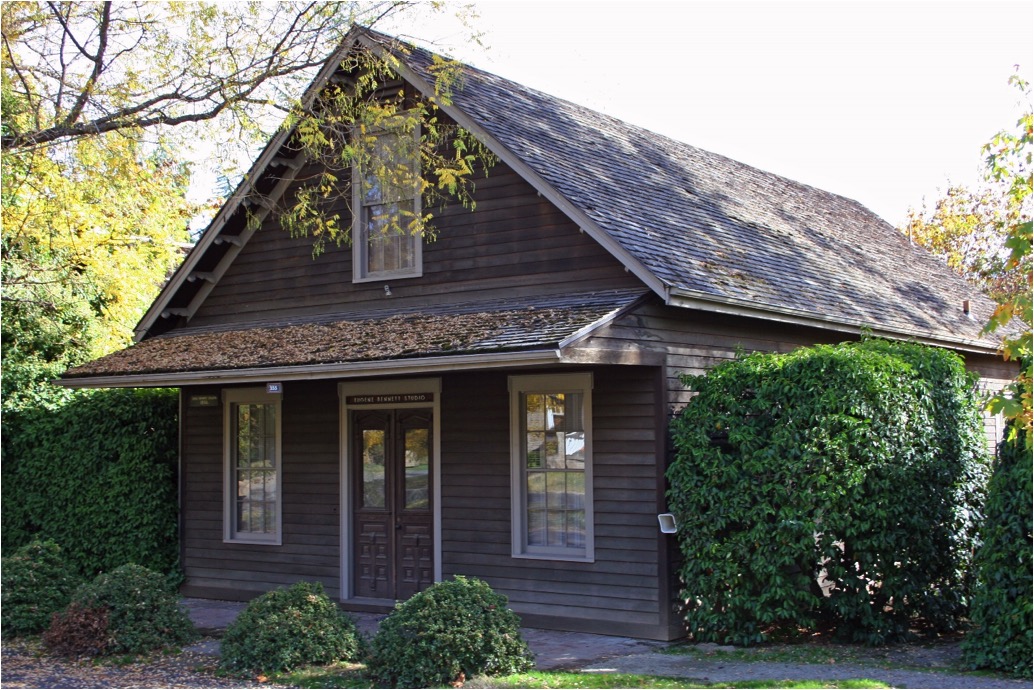 Eagle Brewery Saloon, 2009. Photo credit: Carolyn Kingsnorth. Eagle Brewery Saloon, 2009. Photo credit: Carolyn Kingsnorth.
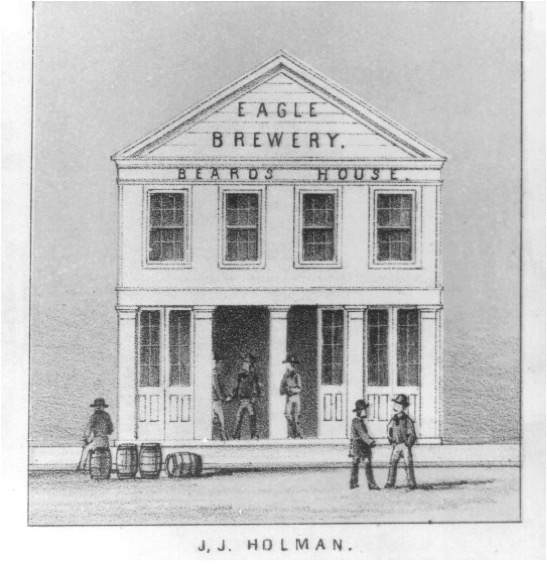 1856 Lithograph of Jacksonville. 1856 Lithograph of Jacksonville. |
The original Eagle Brewery or saloon may have been built as early as 1852 by J.J. Holman on a portion of the site now occupied by the Orth Building (See Stop#22). It is thought to have been the first brewery established in Jacksonville. It was certainly operating by 1856 when Holman appears on local jury lists with his occupation being listed as “brewer.”
At some point prior to 1859, Holman had acquired this 260’ x 290’ foot parcel of land and constructed or moved his brewery to this location. In that year he sold this Southern Oregon Street property “with buildings known as the Eagle Brewery, fixtures, and supplies” to Joseph Gross. Gross in turn quickly sold half interests in the property to Conrad Myer and Joseph Wetterer. Six months later, Wetterer became the sole owner.
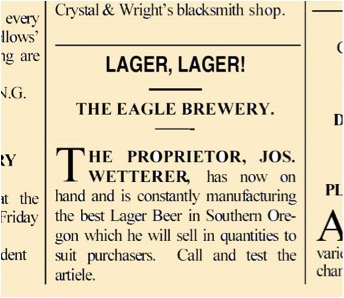 Oregon Sentinel, July 11, 1879. Oregon Sentinel, July 11, 1879. |
Joseph Gross. Gross in turn quickly sold half interests in the property to Conrad Myer and Joseph Wetterer. Six months later, Wetterer became the sole owner.
Little is known about Wetterer. He was a native of Baden, Germany, and immigrated to the U.S. in 1849. It is unclear when he arrived in Jacksonville, but in 1858, he owned the brewery and fixtures on West California Street known as the City Brewery. Subsequently purchased by Veit Shutz, it became the popular Veit Shutz Hall. Its stone cellar can still be viewed from the California Street entrance to the Britt Gardens.
Wetterer was apparently not involved in the town’s social, political, or fraternal activities. There is not even any record of his applying for a liquor license. However, he regularly published advertisements for the Eagle Brewery in local newspapers and an 1879 ad in the Oregon Sentinel promotes “the best Lager Beer in Southern Oregon.”
In June of 1861, a brief item appeared in the Jacksonville papers announced that Wetterer was building a large beer saloon in front of his brewery, and it was predicted that the building would be opened in time for the Fourth of July. The saloon was apparently one long room heated by a wood stove. It was furnished with a “long bar,” tables and chairs, and not much else. A door at the back led to an outdoor beer garden, the cellar, and the brewery.
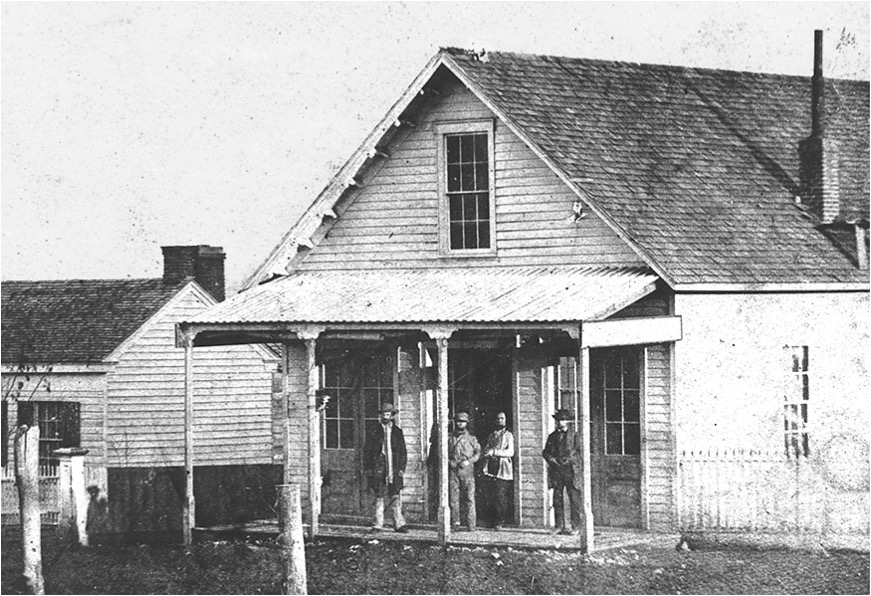 Eagle Brewery Saloon, 1870s. Photo credit: SOHS #21077. Eagle Brewery Saloon, 1870s. Photo credit: SOHS #21077.
Inside the brewery itself was a wood-fired malt kiln for toasting the malt and a wood-fired kettle for cooking the malt. That mixture was cured in wooden vats, bottled or kegged and placed in the cool room. The cool room was insulated with stone and hay, probably with brick floors. Ice cut in winter was the refrigeration.
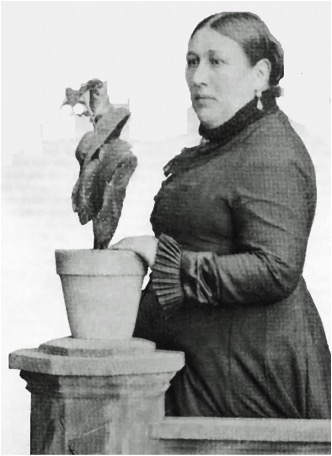 Fredricka Wetterer. Photo Credit: SOHS #13183 Fredricka Wetterer. Photo Credit: SOHS #13183 |
Sometime in the early 1860s Wetterer married Fredricka Sage, also a native of Germany. He constructed a one-story home for them a few feet north of the brewery and saloon buildings. The couple had seven children, two of whom died within two months of each other in 1872. Wetterer himself died in 1879 at the age of 50 after operating the brewery for over 20 years.
Fredricka continued operating the brewery and saloon for a brief period but apparently could not make a “go” of it. In 1881 it was sold at a sheriff’s auction to satisfy a judgment against her deceased husband for unpaid debts. It is unclear who purchased the property, but Fredricka married William Heeley in 1883 and in an 1886-7 Pacific Coast Directory, Heeley is shown as proprietor of the Eagle Brewery.
However, by 1892, the Eagle Brewery with its complex of buildings containing the “malt kiln,” “mash tub,” “cooler,” “furnace heat,” and “beer kettle” was no longer in operation, and the saloon was vacant. An 1898 Sanborn fire insurance map of Jacksonville labeled the old brewery as “Vacant & Dilapidated.”
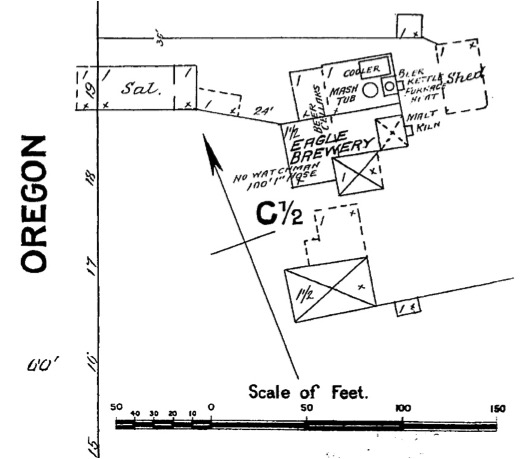 1888 Sanborn Fire Insurance Map 1888 Sanborn Fire Insurance Map |
Sometime after 1907 the saloon was converted to a dwelling, and according to the 1910 census, a widowed Fredricka and three of her children, a son-in-law, and a granddaughter still occupied the complex or at least the saloon and possibly the original house.
The brewery building was probably torn down for salvage during Prohibition.
In 1960, internationally known artist Eugene Bennett acquired the property for his home and studio. He restored the exterior, including adding the cantilevered porch and ornamental entry doors. He built the addition to the left or north side to mimic the original exterior. Today, this is a private residence.
Sources Cited
Evans, Gail E.H. State of Oregon Inventory of Historic Places, “Eagle Brewery Saloon”
1888 Sanborn Fire Insurance Map
The Oregon Sentinel, May 25, 1861; November 21, 1874; April 15, 1878; July 11, 1879.
Jackson County Census, 1860.
Jackson County Census, 1880.
U.S. Federal Census, 1910.
|